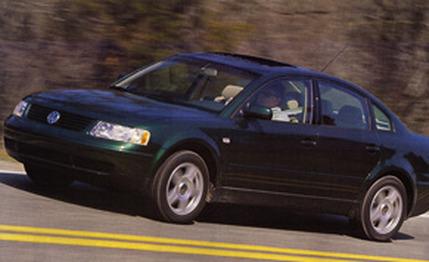 First Drive Review
First Drive Review
That's right. A dozen summers have fluttered by since Volkswagen last offered an all-wheel-drive option in any segment of the new-car market. Okay, a really determined VW-phile could get all-wheel drive in the old Vanagon, a vehicle that made even glaciers look speedy, but few did, and that option disappeared at the end of 1991. Given America's appetite for traction at all four corners -- one of the major excuses folks use to justify buying sport-utility vehicles -- we wondered why VW opted out for so long. And after reflecting on the resuscitation of Subaru in this country, a resurrection that's one part marketing and two parts all-wheel drive, we really wondered why. After all, Subaru is the only purveyor of all-wheel-drive automobiles at the affordable end of the spectrum. Clearly, the opportunity was there, and VW had access to all-wheel-drive hardware via Audi, which it owns and whose Quattro systems date back two decades.
Nevertheless, the last North American Passat (then known as the Quantum) with an all-wheel-drive option was the 1988 wagon. So why the mystifying hiatus? The explanation is simple: VW sold only 3031 '88 Quantums in the U.S., and there was concern about the future, expressed as, "Do we have any future here at all?" VW's fortunes in the U.S. seemed to be circling the drain, and the cost of offering a Syncro model with limited sales potential just didn't make sense.
Fast forward to today. VW sold 315,563 vehicles in the U.S. in 1999, its best year here since 1974. Of that total, 68,151 were Passats -- not a lot by Toyota Camry or Honda Accord standards, but 74 percent more than the year before.
By adding the all-wheel-drive option, Volkswagen expects to expand that total to 80,000 this year and hopes to top 100,000 in '01. This optimism is rooted in more than America's penchant for four-wheelin'. All-wheel-drive Passats account for a resounding 33 percent of the sales mix in other markets, far more robust than the modest 10 percent forecast here.
However, that forecast is based on availability rather than corporate caution. VW actually planned to offer all-wheel-drive Passats to U.S. customers more than a year ago, but the Emden factory in Germany was unable to keep pace with high demand for the new car, and faced with supply constraints, VW abruptly shelved the 1999 program.
We had our hands on one of those never-never '99s, an all-wheel-drive wagon, and put it through its paces at our test track. Since then, VW has changed the marketing name for the system from Syncro to 4Motion, a handle that is more descriptive and emotional, according to the marketing troops. Sure.
Be that as it may, VW, like Audi, uses one term to embrace two distinctly different systems. For example, a VW Golf with 4Motion employs the hydromechanically coupled Haldex system that is used in cars with transversely mounted engines. Cars with north-south engines, such as the Passat, use a system with an auto-locking Torsen center differential. Unlike the Haldex version, the Passat's 4Motion system provides permanent engagement, splitting power 50/50 front-to-rear under normal operating conditions.
The system can vary the front-to-rear power split to roughly one-third/two-thirds at either end, but generally speaking, all four wheels are scratching all the time, and there's no system lag time in transitions from bare pavement to slush and back.
In its front-to-rear apportioning of power, 4Motion is strictly a mechanical system. However, there's also an electronic component -- the electronic differential lock, or EDL -- governing side-to-side power delivery, to compensate for left-side/right-side differences in traction, which the gurus of grip call split mu. Governed by the anti-lock braking sensors, EDL uses brake intervention to control wheelspin, restoring equilibrium and delivering traction even when only one wheel finds grip. It desists when speeds climb above 50 mph, to avoid putting excessive heat into the brakes.